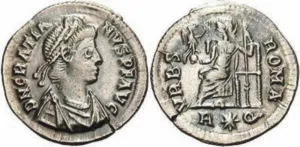The Roman Siliqua: A Historical Overview
By: Jaden Boyd

The Roman siliqua (pronounced sili-kwah), a key currency in the late Roman Empire, holds significant historical value and reflects the economic practices of its time. Emerging in the 3rd century AD, the siliqua was a silver coin, and it became a vital component of the Roman monetary system. Its name is derived from the Latin word “siliqua,” which refers to a pod or husk, hinting at its association with weight measurement in trade.
The origins of the siliqua can be traced back to the Roman Empire’s broader monetary reforms during the reigns of emperors like Diocletian and Constantine. As the empire expanded, the need for a stable and standardized currency became evident. The siliqua was introduced as a part of the silver coinage system and was initially minted in a range of silver content. Over time, it became less valuable due to inflation and the debasement of silver, reflecting the economic struggles of the later empire. The introduction of the siliqua marked a transition in Roman currency, showcasing the empire’s efforts to adapt to changing economic realities.
The iconography of the siliqua is rich and varied, often reflecting the political and cultural dynamics of the time. The obverse typically features the emperor’s portrait, symbolizing authority and legitimacy, while the reverse often depicts various motifs, such as deities, personifications of virtues, or allegorical figures. For instance, the image of the goddess Victoria was frequently used to signify triumph and military success, underscoring the empire’s militaristic ethos. This use of iconography served not only as a means of propaganda, but also as a way to reinforce the emperor’s divine right to rule, connecting the currency to broader themes of power and control.
Economically, the siliqua played a crucial role in facilitating trade and commerce throughout the Roman Empire. As a widely accepted currency, it contributed to the growth of both local and long-distance trade networks. Merchants relied on the stability and recognition of the siliqua to conduct transactions, and its presence in various regions of the empire helped to create a more integrated economic landscape. However, as the quality of silver decreased over time, the siliqua’s purchasing power diminished, leading to economic challenges and the eventual reliance on alternative forms of currency, such as gold and bronze coins.
The historical significance of the siliqua extends beyond its role as a medium of exchange. It encapsulates the complexities of the Roman economy and society during a time of transition and turmoil. The changes in its composition and usage reflect broader economic trends, including inflation, military expenditures, and the eventual decline of the Roman Empire. Moreover, the siliqua remains a subject of interest for numismatists and historians, offering insights into the cultural and political landscape of the late empire.
In conclusion, the Roman siliqua coin is a fascinating artifact that serves as a window into the economic, cultural, and political realities of its time. From its origins in the reformative measures of the Roman Empire to its rich iconography and economic implications, the siliqua provides valuable insights into the complexities of late Roman society. As historians continue to study this coin, it stands as a testament to the enduring legacy of Roman monetary practices and their impact on subsequent economic systems.